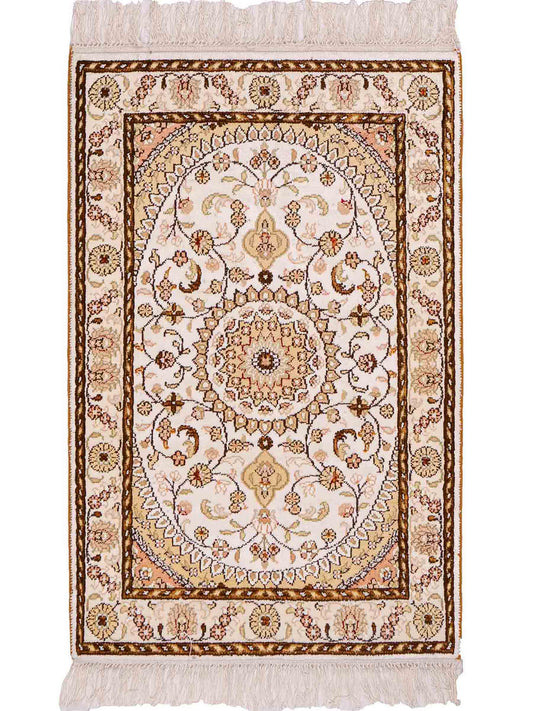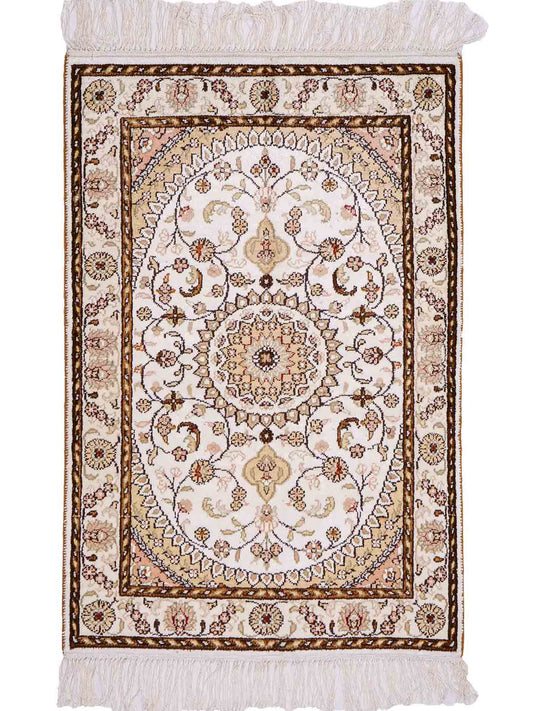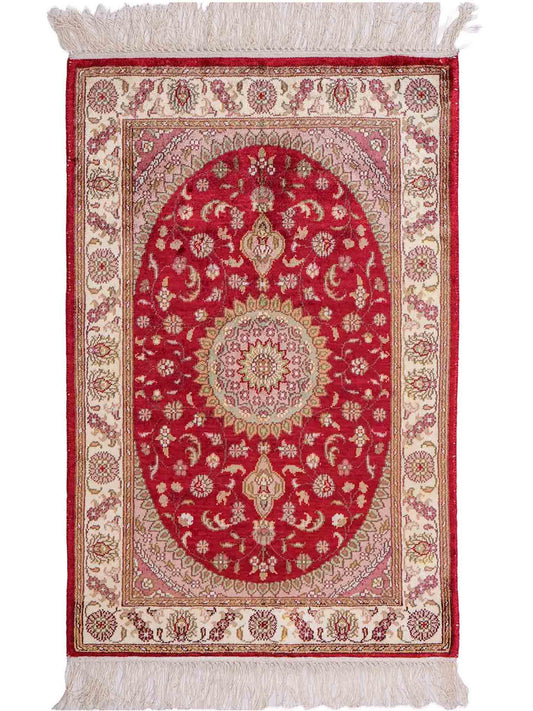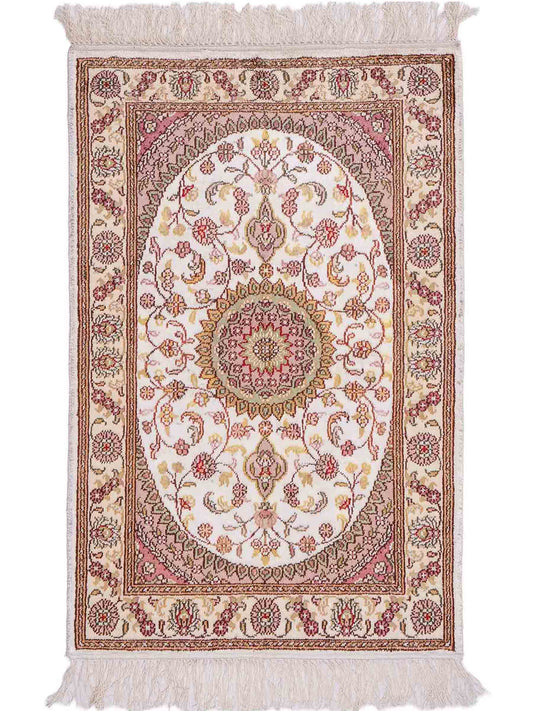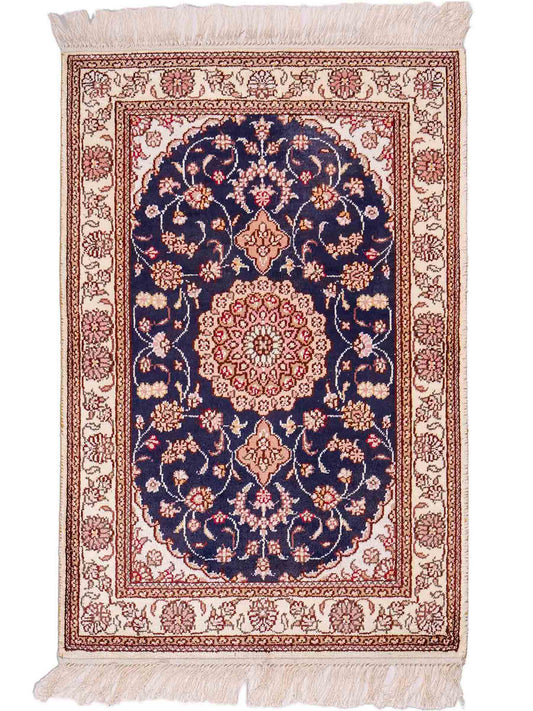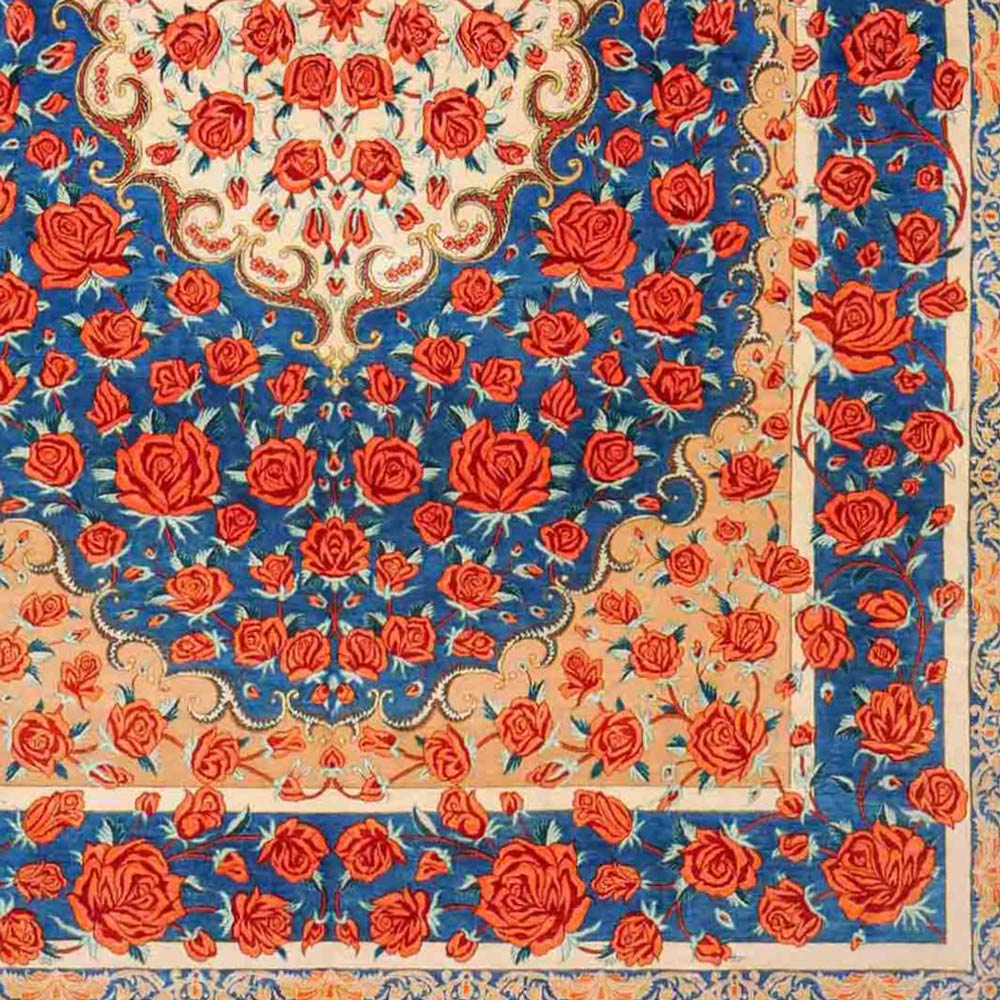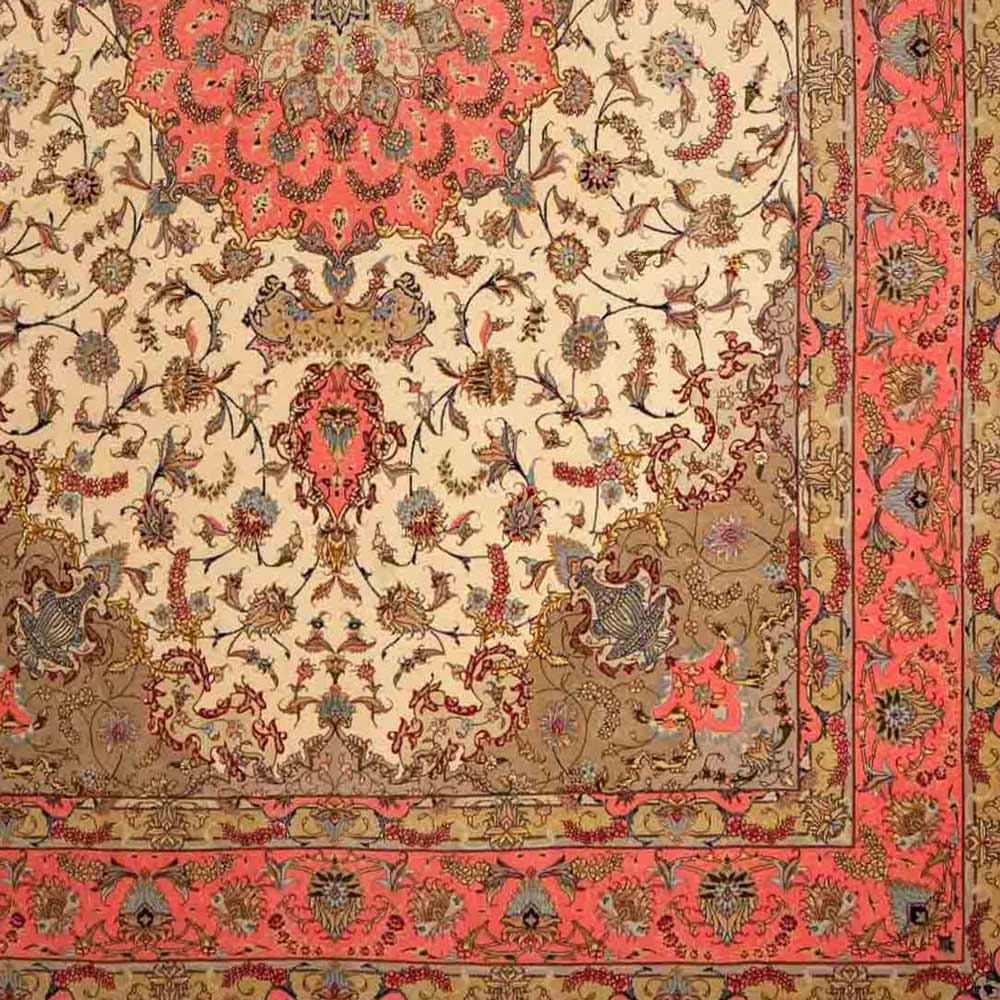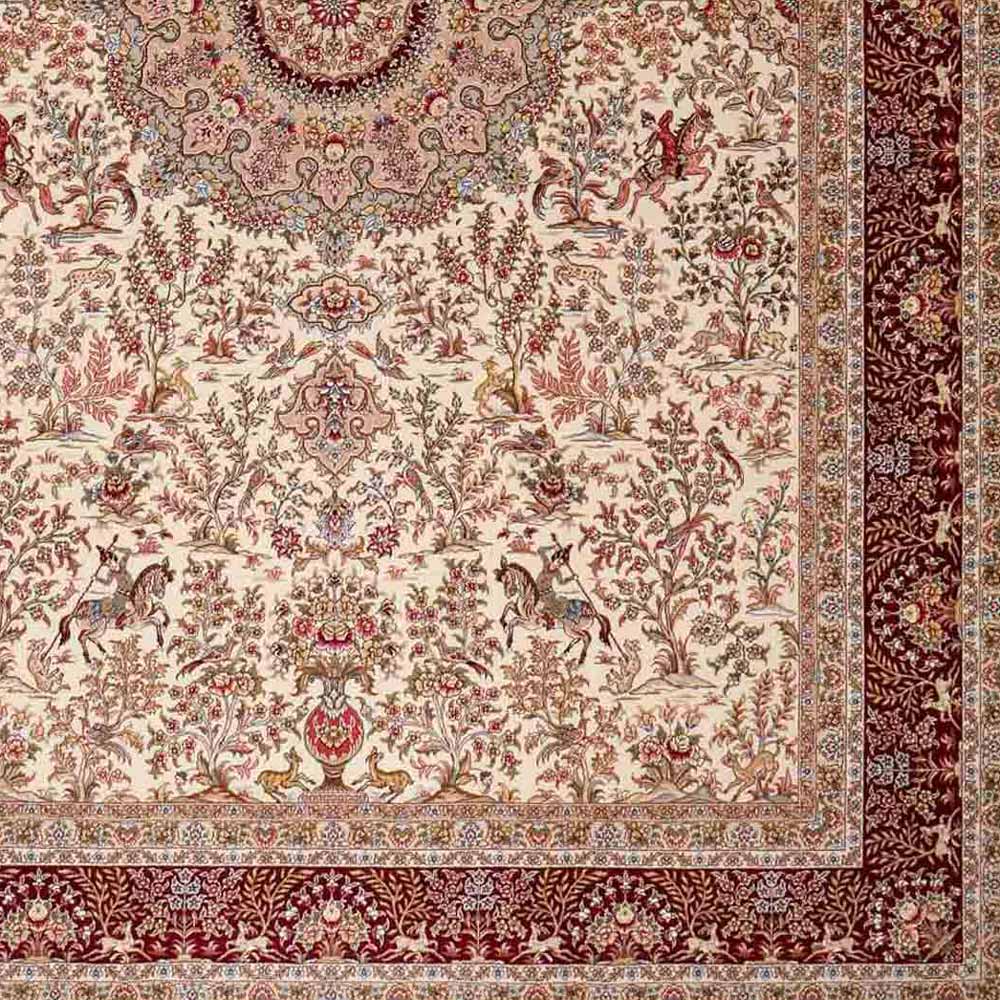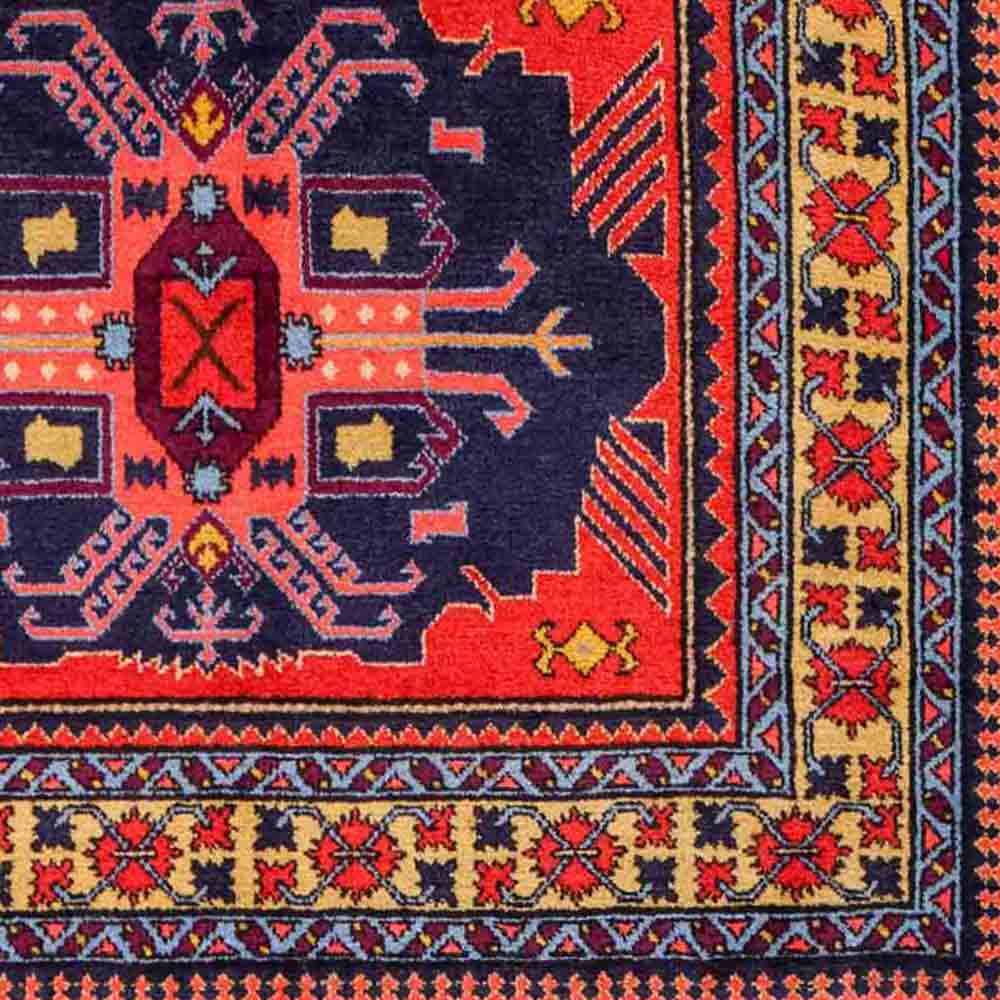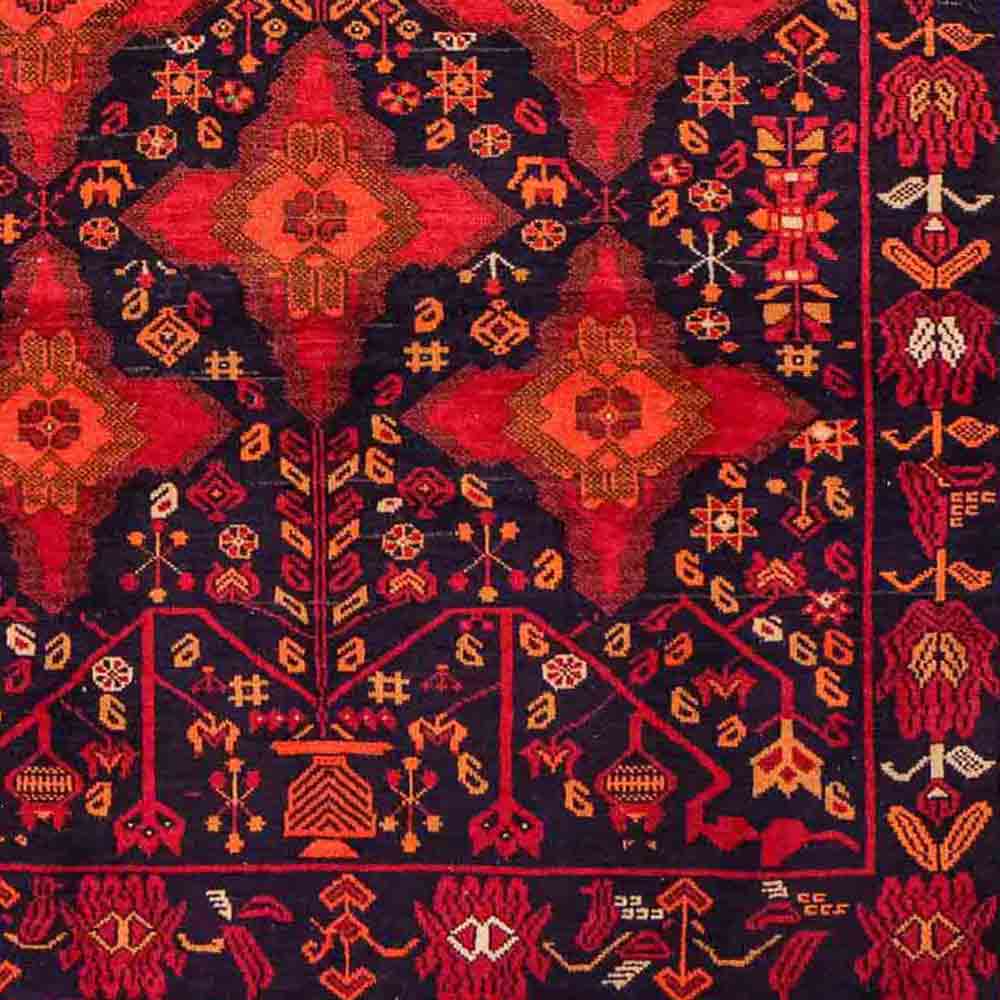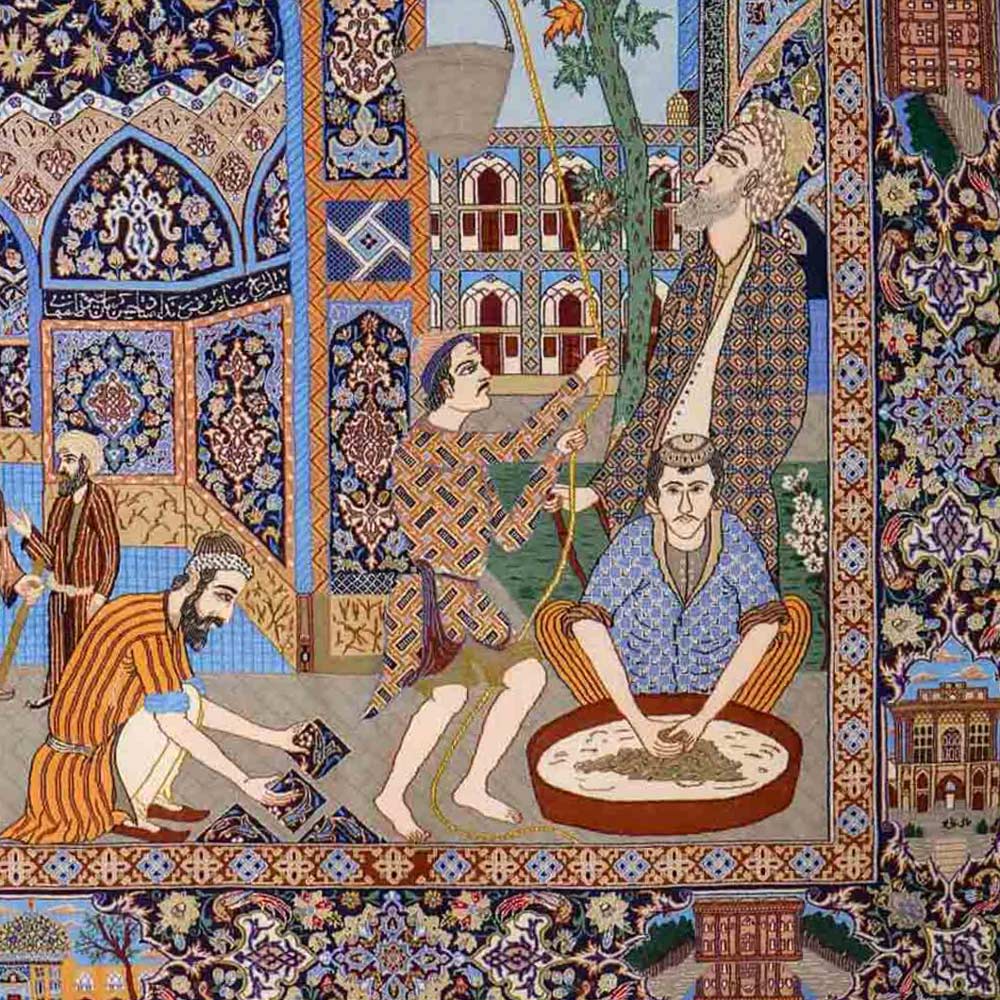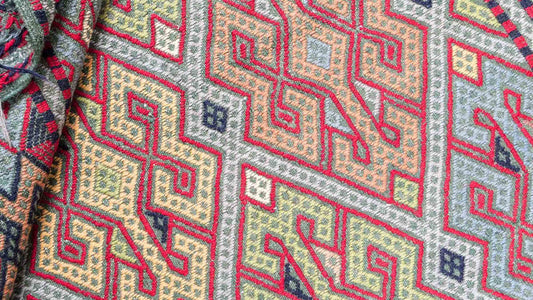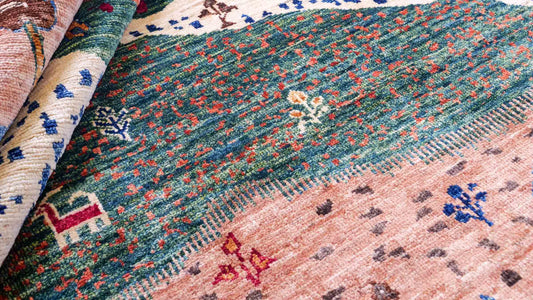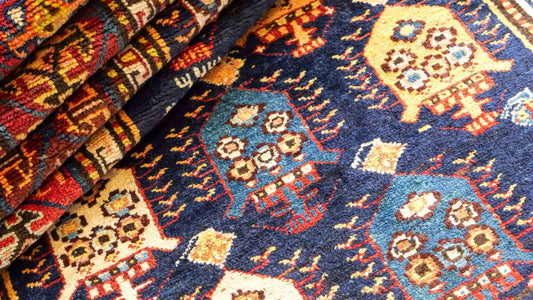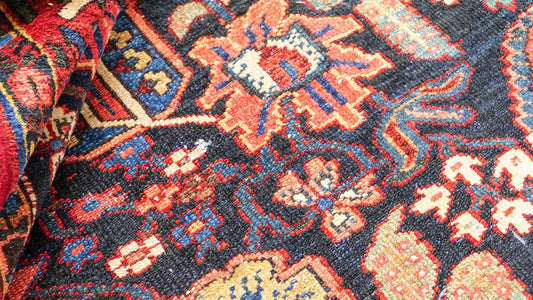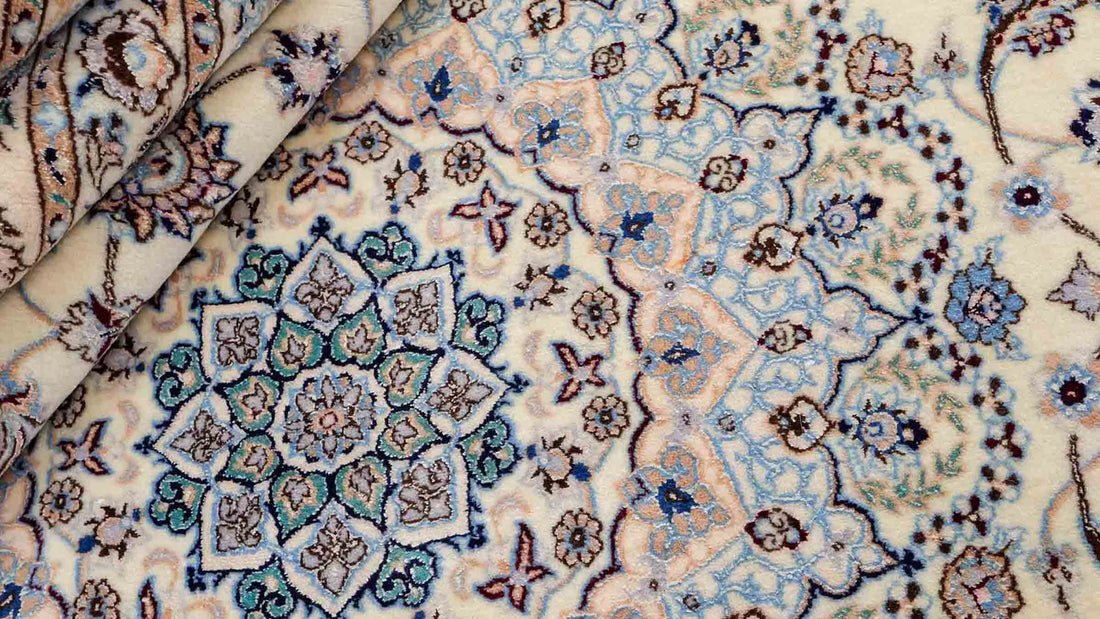
Nain
Daniel KhademiNain rugs are recognized worldwide as symbols of intricate beauty, enduring value, and timeless elegance. These masterpieces of carpet artistry combine deeply rooted traditional craftsmanship with unparalleled material quality—making them a stylish investment for life. In this article, discover everything about the origins, history, designs, color language, care, quality, and investment potential of authentic Nain rugs.
Nain Rugs: Key Facts at a Glance
- Origin: Desert city of Nain, Central Iran (Isfahan province), 1,500 m above sea level
- Materials: Highland wool, cork wool, silk highlights, plant-based dyes
- Design: Floral motifs, medallions, delicate geometric patterns; traditional & modern styles
- Knot Density: High—typically 200,000 to 1,000,000 knots/m², Persian Senneh knot
- Quality: Exquisite handwork, exceptional softness & durability
- Colors: White, cream, indigo, blue, red, green, beige, gold—refined, harmonious color palettes
- Value: Timeless investment, collector’s item, international art object
- Care: Gentle cleaning, professional maintenance recommended (see tips below)
- Investment: Consistent value appreciation, strong demand in the art market
Explore our curated collection of exclusive Nain Rugs & Designs —find your one-of-a-kind masterpiece today!
Origins of Nain Rugs: High-Altitude Tradition in Central Iran
Nain is located in the Isfahan province of central Iran, distinguished by its desert landscape, which gives the region its unique scenery. The city sits 1,500 meters above sea level, surrounded by the impressive Zagros Mountains. These mountains offer a stunning backdrop and also influence the area’s unique microclimate.
Nain experiences a continental, dry climate with hot summers and cold winters—ideal for sheep grazing. The region’s historic pastures were perfect for the growth of local sheep herds, fueling the famous highland wool production that forms the base of Nain’s renowned carpets.
Another key element of the region is its underground water channels, called Qanats. These centuries-old irrigation systems are crucial not only for agriculture but also for the carpet industry—allowing consistent field irrigation and the cultivation of plants that feed local sheep. This sustainable use of natural resources is yet another reason why Nain rugs are so exceptional.
All in all, Nain’s geographic features create the perfect environment for a rich carpet-weaving tradition that has endured for generations and is now celebrated worldwide.
History of Nain Rugs: From Safavid Courts to an Investment Icon
The history of carpet weaving in Nain stretches back to the Safavid dynasty (1501–1722), the golden age of Persian rug art. During this time, Nain experienced a cultural renaissance. The Safavid rulers were not just art patrons but also influential traders and diplomats. Their generous patronage and strong economy allowed Nain’s artisans to refine their designs and adapt them to changing tastes and influences.
A hallmark of this era was the integration of floral motifs and intricate geometric forms that echoed architectural styles and Islamic art. Many of these elements are still present in Nain rugs today and give them their distinctive beauty.
With the rise of international trade in the 19th century, Nain rugs found their way into the homes and hearts of collectors and enthusiasts around the world. Nain rugs were prized not only for their aesthetics but also for the strict quality standards maintained by local craftsmen. Ever since, Nain carpets have been recognized as significant art pieces that reflect both the skill of the region and the rich cultural heritage of Iran. These carpets are far more than functional objects—they are living witnesses to a deeply rooted tradition passed down through the generations.
The Prestige of Nain Rugs: Cultural Heritage & Quality
In Iran, Nain rugs hold a special status, representing both cultural and economic value. They embody the country’s rich legacy, deeply rooted in tradition, reflecting regional values and taste. Nain’s weavers are highly respected for their skill in creating complex designs and sophisticated patterns. Internationally, Nain carpets have earned respect and are sought-after works of art.
In many countries, Nain rugs are valued not only for their artistry but also as secure investments—offering stability even during periods of economic uncertainty. They are regularly featured at prestigious events such as the TEPPICHART in Frankfurt and the ICOC (International Conference on Oriental Carpets), attracting collectors and enthusiasts from all over the globe.
Craftsmanship: The Art of Nain Weaving
- Material Selection: Producing a Nain rug is a time-consuming and highly specialized craft, requiring skill and attention to detail. The raw wool is sourced primarily from Kashmir and lamb breeds known for fine, soft texture. Only the highest quality wool, selected through strict criteria, is used for rug production.
- Washing & Dyeing: The first step is careful washing of the wool, followed by dyeing with natural colorants. This eco-friendly method ensures vibrant, lasting colors that don’t fade over time. Once dyed, the wool is spun into yarn, ready for the precise knotting process.
- Knotting: Nain rugs are made using the Persian knot (Senneh knot), known for its density and strength. Knot counts typically start at around 200,000 knots per square meter, with top pieces reaching over a million knots per square meter. This density allows artisans to create exceptionally durable carpets with incredibly fine, detailed motifs. The entire knotting process can take months, depending on rug size and density.
- Finishing: In the final phase, each rug is washed to remove dirt and loose fibers, edges are trimmed, and fine decorative stitching is added for structure and a flawless finish.
Result: Every Nain rug is a unique piece, distinguished by its characteristic softness, density, and brilliance—ideal for passing down through generations.
Nain Designs & Patterns: Harmony, Elegance, and Symbolism
Nain rugs are known for their sophisticated floral and arabesque motifs—stylized representations of flowers, trees, and other natural forms. These elegant elements mirror not only the natural scenery but are also deeply rooted in Islamic artistic tradition. This influence is evident in the use of flowing lines, symmetrical layouts, and intricate details.
- Floral Motifs: Nain’s signature is its diverse floral patterns. Stylized flowers, trees, and vines grace many Nain rugs, lending organic beauty. These motifs are arranged in harmonious color palettes and exude pure elegance. Designs often feature rosettes, lotus blossoms, and cascading forms, symbolizing blooming landscapes.
- Geometric Patterns: Alongside florals, geometric designs are common in Nain rugs. Inspired by Islamic and Persian art, these symmetrical and recurring forms add visual interest and balance, perfectly complementing the florals.
- Medallion Designs: Central medallions often serve as the focal point—ornate, harmoniously colored, and surrounded by complex borders. The borders are filled with intricate motifs that highlight the floral elements and enrich the overall composition.
- Blend of Tradition & Modernity: In recent years, some Nain weavers have married traditional designs with contemporary touches—often more minimalist—making these rugs ideal for modern interiors.
The Traditional Nain Rug Color Palette
The colors of Nain rugs are a key part of their beauty and expression, each shade chosen to achieve harmony between tradition and modern design. The most common colors:
- White and Cream: Frequently dominate Nain rugs, creating a clean, fresh base. These shades make other colors more vibrant, symbolizing purity, light, and peace, and help spaces appear brighter and larger.
- Blue and Indigo: Multiple shades of blue evoke the skies and water. They radiate cool elegance and often have a calming effect. Blue is associated with serenity, harmony, and the infinite, lending timeless charm.
- Red and Burgundy: Rich reds express energy and passion, adding depth and drawing the eye. Red stands for warmth, strength, and vitality, bringing vibrancy to the design.
- Green and Dove Blue: These soft, natural tones underscore floral motifs and foster a serene, inviting ambiance. Green represents growth and nature, while dove blue provides a refined gentle note.
- Beige and Gold: These subtle tones round out Nain’s color palette with elegance. Beige conveys neutrality and warmth, gold symbolizes luxury and wealth. Together, they create a timeless, classic look suited to many styles.
Many Nain weavers also use gray, terracotta, and soft earth tones for added complexity. Their expert combination—often achieved through natural dyeing—ensures each rug looks both traditional and up-to-date.
Nain Rugs Compared to Other Persian Classics
| Feature | Nain | Bijar | Hamadan | Tabriz |
| Herkunft | (Central Iran, near Isfahan) | Bijar (West Iran, Kurdistan) | Hamadan (West Iran) | Tabriz (NW Iran, Azerbaijan) |
| Origin |
Fine wool with silk | Very dense wool | Coarse to medium wool | High-quality wool, some silk |
| Knot Density |
200,000–1,000,000 knots/m² | 250,000–600,000 knots/m² | 100,000–300,000 knots/m² |
150,000–1,000,000 knots/m² |
| Design/Pattern | Florals, medallions, arabesque | Robust, often heraldic/geometric/floral | Simple to geometric/floral | Medallion, floral, geometric, tableau, figural |
| Surface |
Soft, slightly lustrous, fine |
Extremely robust, thick/dense | Tough, coarser, durable |
Smooth, sometimes silky sheen |
| Colors | Cream, blue, beige/ivory, gold | Red, blue, beige/ochre, bold | Bold red/blues, earth tones |
Rose, gold, red, blue, green |
| Highlights |
Elegance, high silk content | The “iron rug”—legendary durability | Everyday classic, affordable |
Precision, variety, fine details |
| Value/Price | High, strong appreciation potential | Mid-high, very durable | Entry-mid, solid value | High, strong appreciation |
Nain Rug Quality & Authenticity Checklist
- Is the wool highland (or cork) wool? ✔
- Are silk highlights present (e.g., in pattern details)? ✔
- Is the knot density at least 200,000 knots/m² (premium >500,000)? ✔
- Are floral motifs, medallions, and fine patterns clearly visible? ✔
- Are the colors (especially white, blue, red, cream, gold) clear and natural? ✔
- Is the workmanship on the edges, fringes, and back flawless? ✔
- Is a certificate of origin or authenticity included? ✔
- No artificial shine or chemical smell? ✔
- Does the rug feel soft yet compact and dense? ✔
- Are complete care instructions provided? ✔
Tip: If all boxes are checked, you have an authentic, value-stable Nain!
Care & Longevity: Preserving Your Nain Rug
Keeping Your Nain Rug Radiant for Generations:
- Vacuum regularly with gentle settings; do not beat the rug
- Blot spills quickly with lukewarm water and a clean cloth
- Avoid direct sunlight to prevent fading
- Professional cleaning every 1-2 years is highly recommended
- For more detailed advice, visit our blog post: *How to Care for Hand-Knotted Rugs*
Styling Tips for Nain Rugs
Nain rugs—with their delicate color palettes and fine, intricate patterns—are ideal for elegant, romantic interiors. They pair beautifully with modern, minimalist, or Scandinavian styles, where their subtle beauty stands out without overwhelming the space. A Nain rug in a light living room or bedroom adds calm and sophisticated visual interest.
When placing a Nain rug, consider the proportions and base colors of your furniture. Large rugs work well in open spaces, while smaller ones serve as accents in reading nooks or beside the bed. Match your rug’s color shades throughout your décor—in pillows, curtains, or wall paint—for a seamless look.
Nain Rugs: Collectibles & Investment Potential
Purchasing a Nain rug means acquiring art, historic craft, and lasting value.
- Value Appreciation: Top-quality Nain rugs often gain value over time, thanks to intricate technique, rare materials, and unique designs. Well-preserved examples are prized by collectors and have remarkable investment potential.
- Collector’s Items: Nain rugs come in an array of styles and sizes to satisfy every collector’s taste. A thoughtfully chosen Nain rug tells stories, becomes a family heirloom, and enhances exhibitions or private collections for generations.
In an age of mass production and disposable goods, handmade treasures like Nain rugs grow ever more relevant and desirable.
► For detailed tips & in-depth guidance, see our blog post: *Are Hand-Knotted Rugs a Good Investment?*
Request a free personal style or purchasing consultation for Nain rugs today!
FAQ – Frequently Asked Questions About Nain Rugs
What makes a genuine Nain rug?
► Fine highland wool, silk highlights, high knot density, masterful handwork, and floral designs.
How can I recognize an authentic Nain?
► Certificate of authenticity, meticulous finish, velvet-like touch, minimal irregularities on the back, classic colorways.
Are Nain rugs suitable for everyday use?
► Yes. With proper care, they’re robust and perfect for living rooms and bedrooms.
How do I care for a Nain rug?
► Gentle cleaning, professional maintenance, avoid harsh sunlight/chemicals. More tips in our blog: *How to Care for Hand-Knotted Rugs*
Do Nain rugs appreciate in value?
► Especially fine Nain rugs regularly appreciate (5–10% per year for top pieces)—read more in our blog post: *Are Hand-Knotted Rugs a Good Investment?*
Where can I buy quality Nain rugs?
► Only from specialist dealers and reputable online shops—always check for certificates of authenticity and expert advice. At JUPITER Intl, every hand-knotted, hand-tufted, and handwoven rug comes with a Certificate of Authenticity.
Conclusion: Nain Rugs – Heritage, Beauty & Enduring Value
Nain rugs are a remarkable example of Persian carpet artistry. They not only embody exquisite techniques but also carry a piece of history and culture into every space. Their geographic roots, storied past, exquisite workmanship, high knot count, elegant designs, and refined color palettes make Nains coveted art objects. Compared to other renowned weaving regions like Ghom or Isfahan, Nain offers an impressive blend of outstanding quality and accessibility. Thanks to their quality, artistry, and cultural significance, Nain rugs have claimed their place on the international market and are prized by collectors and enthusiasts worldwide.
Explore our curated collection of exclusive Nain Rugs & Designs —find your one-of-a-kind masterpiece today!
Related blogs & blog posts you might also be interested in:
→ Design Classics, Countries of Origin, Carpet Materials, Carpet Guide

